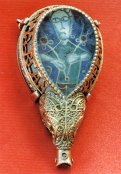

One of the most famous objects to survive from Anglo-Saxon England is the Alfred Jewel, traditionally associated with Alfred the Great, king of the West Saxons 871-99. The jewel was found in 1693, at North Petherton, on land belonging to Sir Thomas Wroth (c.1675-1721), only four miles from Athelney, where King Alfred took refuge from the Vikings in 878, and where he is alleged to have burnt the cakes.
North Petherton was mentioned in the Domesday Book as Norperet 1086 (Meaning the north enclosure of the river Parret).
Both of the Manors belonged to King Edward and were taken by King William after 1066.
North Petherton forest and park closely linked North Petherton with Medieval Kings of England.
King John used Bridgwater Castle on occasions when he came for the hunting in North Petherton Forest.
Bridgwater Castle was built between 1200 and 1210. Its walls were 12 to 15 feet thick and it was surrounded by a 30 foot moat.
The castle survived until 1646, when in the year after the Civil War reached Bridgwater, it was destroyed.
Geoffrey Chaucer (c. 1343-1400) The greatest English poet of the Middle Ages, Chaucer is best known for "The Canterbury Tales" and the contribution to English literature that he made by writing his verses in English instead of Latin which was the norm at the time. Under Richard II, Chaucer was appointed Clerk of the King's Works in charge of construction and renovation. His last official post was as deputy forester of the royal forest of North Petherton. He was born in London, married Philippa in his early twenties and had two sons, Lewis and Thomas. He is buried in Westminster Abbey.
Historians are divided over Geoffrey Chaucer's involvment in the Park. Some say he lived in the Park House in the Park House Field, now known as Parkers Field. This was probably the lodge which housed the foresters and which the historian, Leland noted in the early 16th century was surrounded by a moat. Others say it was unlikely that he ever lived in or even visited Somerset.
A skirmish took place between a royalist supply convoy and a parlimentary force in North Petherton in August 1644.